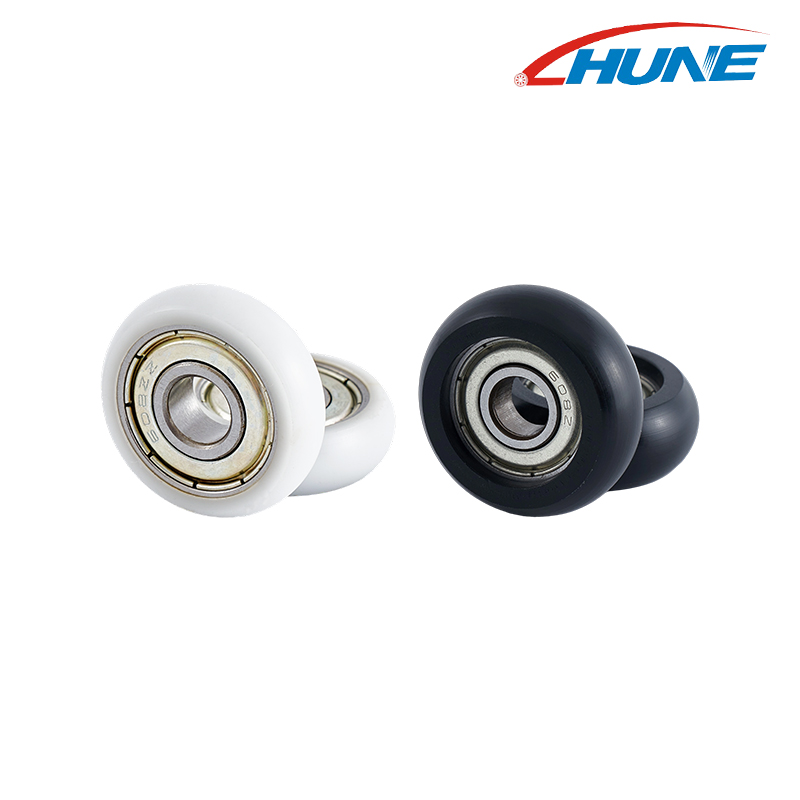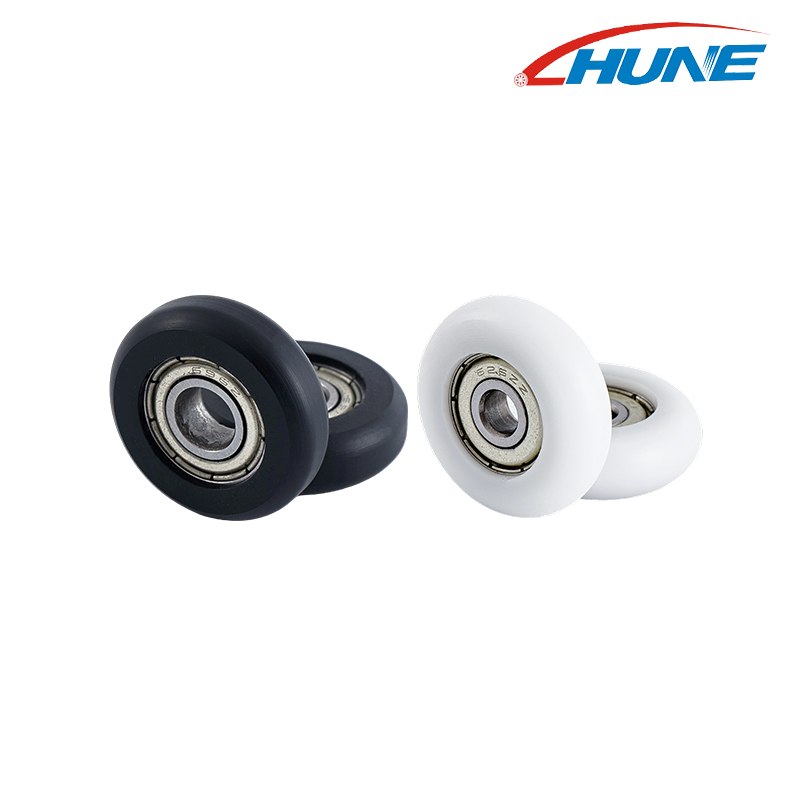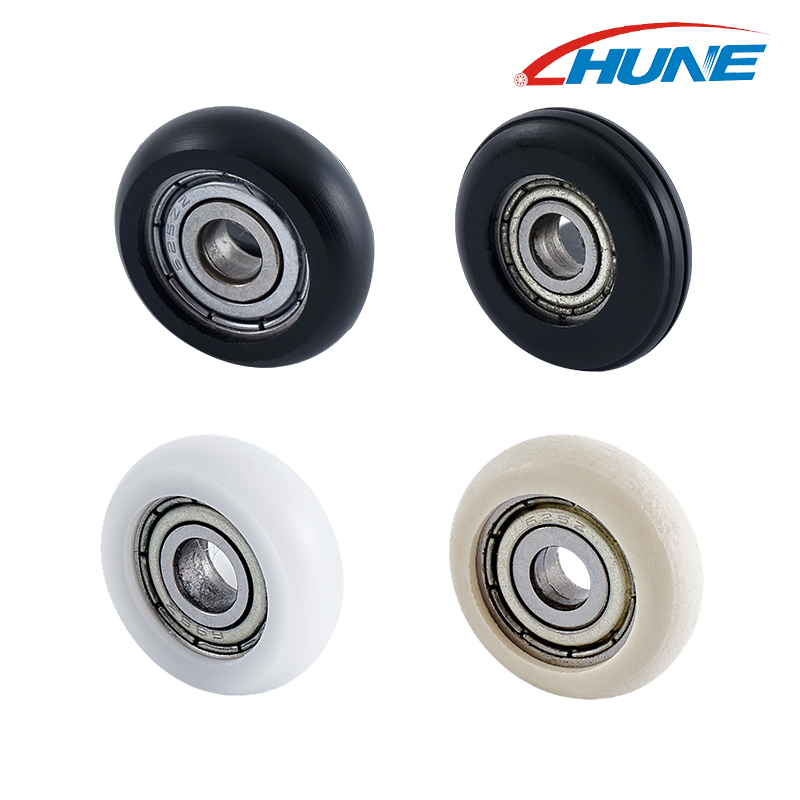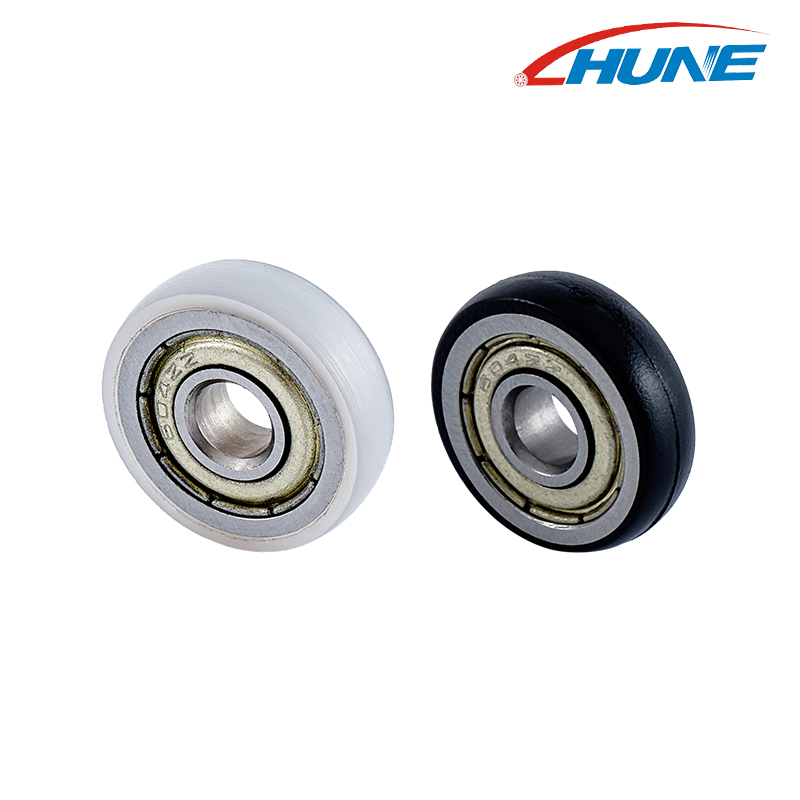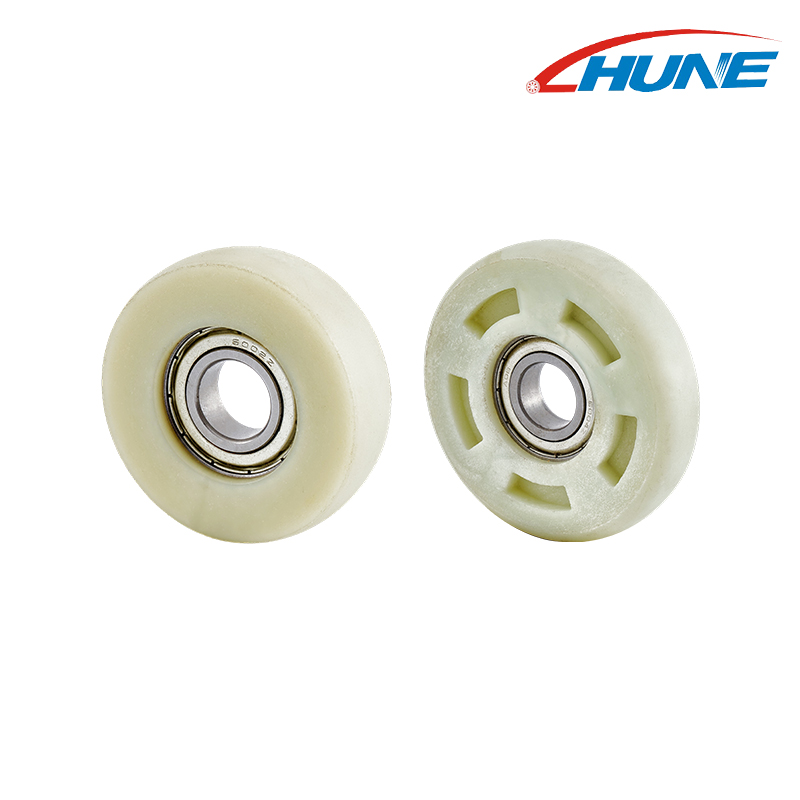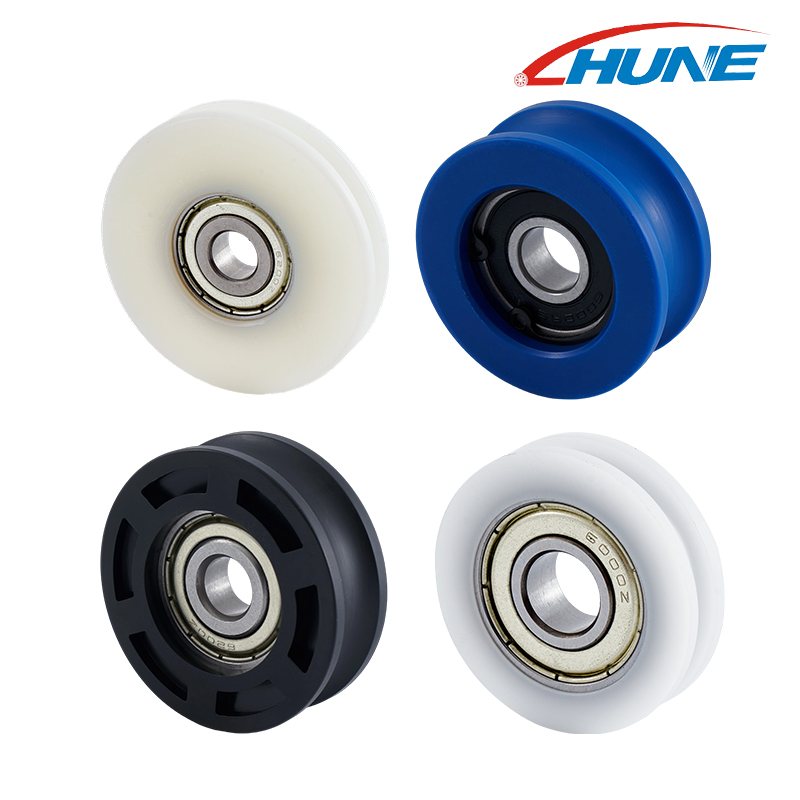Introduction to Plastic Bearing Pulleys
Plastic bearing pulleys are an increasingly popular mechanical component that play a vital role in a variety of industries. They simplify motion and operation by changing the direction of force or providing a mechanical advantage. Plastic bearing pulleys are increasingly being adopted due to their unique advantages over traditional metal pulleys, such as lightweight, corrosion resistance, and noise reduction.
This article will delve into the world of plastic bearing pulleys, detailing their composition, different types, materials used, advantages and disadvantages, widespread applications, and factors to consider when selecting and maintaining these critical components. We will also compare plastic pulleys to metal pulleys and look at future development trends, aiming to provide you with a comprehensive guide to plastic bearing pulleys.
What is a plastic bearing pulley?
Definition and composition
A plastic bearing pulley is a wheel made of plastic material with bearings integrated inside or around it to support a rotating shaft or component while reducing friction. A typical plastic bearing pulley mainly consists of the following parts:
Plastic Wheel: This is the body of the pulley, usually made of high-performance engineering plastics, and its shape and groove are designed according to the application requirements (such as V-groove, flat belt groove or tooth groove).
Bearing: The bearing is the core component of the pulley, which allows the wheel to rotate freely with minimal friction. Depending on the type, the bearing can be a ball bearing or a sleeve bearing.
Housing/Mounting: Some pulleys include a housing or mounting to hold the bearing and pulley and integrate it into a larger mechanical system.
How it works
Plastic bearing pulleys work similarly to conventional pulleys, with the core being to use the rotation of a wheel to change the direction of motion of a rope, belt or chain, or to achieve effort saving through the principle of leverage. When force is applied to the rope or belt attached to the pulley, the pulley is free to rotate supported by the bearing, allowing the load to move smoothly and efficiently. The presence of the bearing significantly reduces the friction between the wheel and the fixed shaft, ensuring smooth movement and efficient transfer of energy. The use of plastic materials further reduces inertia and can provide better performance than metal in certain environments.
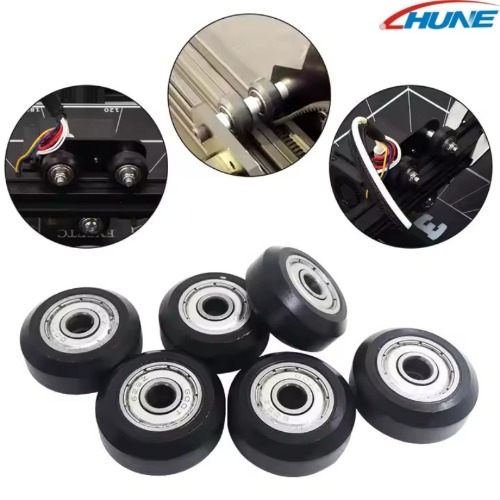
What types of plastic bearing pulleys are there? What applications are they suitable for?
Plastic bearing pulleys are widely used in automation equipment, home appliances, fitness equipment, door and window systems, conveying equipment and other industries. Compared with metal pulleys, plastic pulleys have the advantages of light weight, corrosion resistance, low operating noise and lower cost. Plastic pulleys can be classified in many ways according to the structure, groove type and bearing configuration, and each type has its specific use and performance characteristics.
Why choose plastic bearing pulleys?
Lightweight: Reduce equipment load, save energy and reduce noise
Corrosion resistance: Suitable for humid or chemically corrosive environments
Low noise: Suitable for places that require quiet operation
Reasonable price: Suitable for mass production
Highly customizable: Size, color, and material can be designed on demand
Common Types of Plastic Bearing Pulleys
Here are the most widely used types of plastic bearing pulleys, categorized by shape, structure, and bearing configuration:
| Type | Description | Common Applications | Bearing Type | Material |
| Flat Pulley | A smooth flat surface ideal for flat belts or cable movement. | Printers, office machines | Ball bearing (metal/plastic) | Nylon, POM, ABS |
| V-Groove Pulley | Features a V-shaped groove to guide ropes or cables precisely. | Sliding doors, curtain rails, hoists | Sealed ball bearing | Nylon, PP |
| U-Groove Pulley | U-shaped groove fits round cables or wire ropes snugly. | Garage doors, lifting devices | Deep groove ball bearing | Polyamide, HDPE |
| Round Belt Pulley | Designed specifically for round belts in light-duty drives. | Fitness machines, sewing machines | Plastic sleeve bearing | Delrin, POM |
| Tension Pulley | Used to maintain tension in a belt or chain system. | Automotive timing systems, industrial drives | Double shielded bearings | PA6 + fiberglass |
| Guide Pulley | Guides and aligns moving ropes or wires in a system. | Blinds, elevators, conveyors | Plain or rolling bearing | Polycarbonate, Nylon |
| Double-Groove Pulley | Two grooves allow dual belt or rope management. | Dual track doors, automation systems | Precision ball bearing | POM, PA66 |
How to choose a suitable plastic bearing pulley?
Load requirements: confirm whether the pulley and bearing can withstand the working load
Working environment: whether it is resistant to high temperature, corrosion and UV
Operation speed: low friction and high precision bearings are recommended for high-speed applications
Noise requirements: silent bearings should be used for equipment that needs to run quietly
Installation structure: select matching models according to shaft diameter, installation method, etc.
Brief analysis of common plastic materials:
Nylon (PA): high strength, wear resistance and good toughness
POM (polyoxymethylene): low friction and dimensional stability
ABS: low price and good formability
Polycarbonate (PC): high impact resistance and transparent material optional
Glass fiber reinforced material: suitable for high strength and high load environment
| Nylon | PA | POM | Poly | ABS |
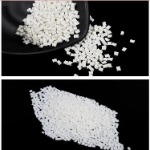 |
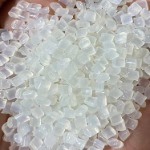 |
 |
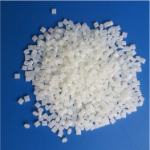 |
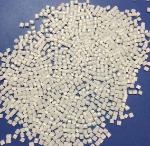 |
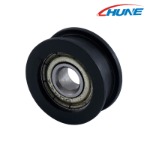 |
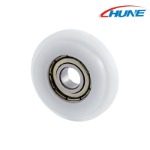 |
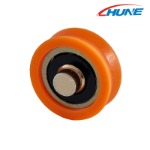 |
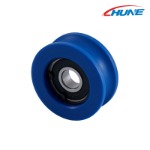 |
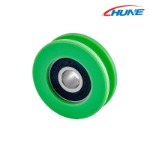 |
Plastic bearing pulleys are increasingly replacing traditional metal pulleys due to their diverse structures, excellent performance and cost advantages. Different types of pulleys are suitable for different application scenarios. Users should consider load, environment, speed and installation method when selecting. Choosing the right pulley will directly improve the stability and service life of the equipment.
Advantages of Using Plastic Bearing Pulleys
In modern mechanical systems, pulleys are an indispensable key component in transmission and guide systems. With the development of materials science, plastic bearing pulleys have gradually replaced traditional metal pulleys in many fields due to their significant advantages such as lightweight, corrosion resistance, and low noise, and have become an important choice for industries such as industry, home appliances, and logistics transportation.
Main advantages of plastic bearing pulleys
Light weight and reduced energy consumption
Plastics have a lower density than metals, and the overall weight of the pulley is lighter, which helps to reduce the load of the whole machine, reduce energy consumption, and improve the operating efficiency of the equipment.
Corrosion resistance and adaptability to complex environments
Plastic materials such as nylon, POM, and polycarbonate have good water resistance, acid and alkali resistance, and are suitable for high humidity, salt spray or chemical corrosion environments.
Silent operation, improve user experience
Plastics themselves have shock absorption properties, and with high-quality bearings, the noise generated during operation is much lower than that of metal pulleys, which is particularly suitable for noise-sensitive applications such as medical equipment and household appliances.
Lower cost, suitable for mass production
Plastic injection molding has high efficiency and low production cost, which is suitable for large-scale manufacturing and reduces the assembly cost of the whole machine.
Strong customizability and diverse structures
Plastic processing is highly flexible, and pulleys of various structures and colors can be developed according to different design requirements to meet the use of special scenarios.
Comparison table of advantages of plastic pulleys and metal pulleys
| Compare Projects | Advantages of Plastic Bearing Pulleys | Disadvantages of Metal Bearing Pulleys |
| weight | Lightweight, easy to reduce weight and save energy | Heavy weight, easy to increase equipment load |
| Corrosion resistance | Anti-corrosion, anti-moisture, suitable for harsh environments | Easy to rust, need additional protection |
| Operating noise | Quiet operation, low vibration | Hard contact, loud noise |
| Manufacturing Cost | Low material and production costs, suitable for mass production | High cost and complicated processing |
| Processing flexibility | Easy to shape, color/structure can be customized | Processing limitations, long customization cycle |
| Wear resistance | Excellent wear resistance after adding glass fiber reinforcement | Raw metal is wear-resistant but requires more precision in processing |
| Lubrication requirements | Optional lubrication-free bearings, low maintenance cost | Most require regular lubrication, high maintenance costs |
Application scenario examples
Home appliance field: such as washing machines, electric fans, sweeping robots, etc., pursue low noise and lightweight design.
Automation equipment: such as conveyor lines, printers, dispensing machines, etc., emphasize operating stability and energy-saving performance.
Door and window hardware: sliding doors, curtain tracks, etc. require smooth sliding, quiet, and anti-corrosion.
Logistics handling: lightweight pulley systems can reduce the energy consumption of transportation tools and improve handling efficiency.
Plastic bearing pulleys are gradually becoming the preferred components in modern equipment design due to their series of performance advantages. While ensuring operational reliability, they also greatly improve the overall cost performance of the system. For industries that focus on quietness, corrosion resistance, and cost control, plastic bearing pulleys are undoubtedly a wise choice.


Disadvantages of using plastic bearing pulleys
Although plastic bearing pulleys are widely used in many fields due to their advantages such as light weight, low cost and low operating noise, it does not mean that they are suitable for all working conditions. In some specific high-strength or high-temperature applications, the physical and chemical properties of plastic pulleys may not meet the requirements and have certain limitations.
Main Disadvantages of Plastic Bearing Pulleys
Limited load-bearing capacity
The strength and rigidity of plastic materials are generally lower than those of metals. Excessive loads can easily cause the pulley to deform, crack, or even break.
Poor high temperature resistance
Most plastics will soften or even melt in high temperature environments, resulting in structural failure and cannot be used in high-temperature transmission systems.
Susceptible to UV aging
Some plastic materials are prone to aging, brittleness, and loss of toughness under long-term sunlight exposure, affecting their service life.
Large thermal expansion coefficient
When the temperature changes drastically, the dimensional stability of plastic pulleys is poor, and they are prone to jamming or eccentricity problems.
Wear resistance is not as good as metal
Although some reinforced plastics have good wear resistance, they are still prone to wear under high-frequency and high-speed friction conditions.
Sensitive to solvents/chemicals
Some plastics are unstable to acids, alkalis, and organic solvents and may degrade or swell in certain chemical environments.
Comparison table of shortcomings of plastic pulleys and metal pulleys
| Compare Projects | Disadvantages of Plastic Bearing Pulleys | Performance of Metal Bearing Pulleys |
| Carrying capacity | Limited load-bearing capacity, easy to deform under heavy load | High-strength material, suitable for large load systems |
| High temperature resistance | It softens easily when heated, and the structural strength decreases | Able to withstand high temperatures, stable structure |
| Anti-aging | Easily aged by ultraviolet rays, ozone, etc. | Long life and strong aging resistance |
| Dimensional stability | Thermal expansion and contraction are obvious, which affects the accuracy | Small thermal expansion, better stability |
| Wear resistance | Long-term high-speed operation is prone to wear | Strong wear resistance, suitable for continuous high-load operation |
| Chemical resistance | Unstable to some chemicals | Specific alloys are resistant to a variety of corrosive media |
| Structural rigidity | Poor rigidity, large pulleys are prone to deflection | Stable structure and small deformation |
In which scenarios is it not recommended to use plastic bearing pulleys?
High-temperature operating equipment: such as engine periphery, heating and drying system
Heavy industrial machinery: transmission devices that need to continuously carry high torque or heavy load
Outdoor strong light exposure area: such as outdoor solar equipment, open-air elevator system
High-speed rotation system: such as main drive shaft, turbine core part
High-precision positioning requirements: plastic expansion can easily affect the accuracy and stability of equipment
How to avoid the limitations of plastic pulleys?
Use high-performance modified plastics such as glass fiber reinforcement and carbon fiber filling
Add anti-UV agent and flame retardant to enhance outdoor and high temperature adaptability
Joint design: plastic outer wheel + metal inner skeleton to improve strength and thermal stability
Avoid continuous overload operation, clarify the working environment and load range before use
Although plastic bearing pulleys have many advantages, their performance is limited under special conditions such as high temperature, high load, and harsh chemical environment. When selecting, you should fully understand the equipment operating parameters and environmental factors, and comprehensively consider material performance, structural form and service life. If there are high requirements for the load-bearing capacity, temperature resistance or dimensional accuracy of the pulley, metal or mixed material pulleys should still be considered as alternatives.
Considerations for Selecting Plastic Bearing Pulleys
Selecting the right plastic bearing pulley is critical to ensuring system performance and longevity. Here are the key factors to consider:
Load Capacity
How to determine the required load capacity: This is the first and foremost factor in selecting a pulley. You need to know the maximum radial (perpendicular to the axis) and axial (along the axis) loads that the pulley will be subjected to during operation.
Calculate or estimate: Calculate or estimate the expected loads using system design parameters (such as the weight of material carried, belt or rope tension).
Safety Factor: Always add a safety factor (usually 1.5 to 2 times) to the calculated load capacity to account for unexpected shock, vibration, or stress from prolonged operation.
Materials and Size: Load capacity is directly related to the strength of the plastic material, the diameter and width of the pulley, and the type and size of the bearings.
Environmental Conditions
Temperature, Chemical Exposure, etc.: The environment in which the pulley operates can have a huge impact on its performance and life.
Temperature Range: Determine the maximum and minimum operating temperatures. Make sure the heat deflection temperature and operating temperature range of the selected plastic material cover these limits to avoid creep, softening, or embrittlement.
Chemical Exposure: If the pulley will be exposed to water, oil, acid, alkali, solvents, or other corrosive substances, it is important to select a plastic material with excellent chemical resistance (for example, PP has good resistance to many chemicals, while nylon may be damaged in strong acids or alkalis).
Humidity and Dust: High humidity environments may affect the dimensional stability of some plastics. The presence of dust or abrasive particles may accelerate wear, and it may be necessary to select a more wear-resistant material or a pulley with sealed bearings.
Speed Requirements
Effect of Speed on Pulley Performance: Operating speed is also critical to pulley selection.
Frictional Heat: Higher speeds generate more frictional heat, which can cause plastics to heat up and affect their mechanical properties.
Bearing Type: High-speed applications often require low-friction, high-precision ball bearing pulleys that can withstand high-speed rotation. Sliding bearings may generate too much heat or wear too quickly at high speeds.
Dynamic Balancing: Dynamic balancing of pulleys is also important in high-speed applications to reduce vibration and noise.
Pulley Size and Dimensions
How to Choose the Right Size: Make sure the physical dimensions of the pulley are compatible with your mechanical system.
Diameter: Affects the bend radius of the belt or rope, speed ratio, and overall system space.
Width/Groove Type: Must match the type (V-belt, flat belt, synchronous belt) and size of the belt, rope or chain you are using.
Bore/Shaft Hole Size: Must match the diameter of the mounting shaft to ensure a secure fit.
Mounting: Consider whether you need a flanged housing with bearings or a simple wheel.

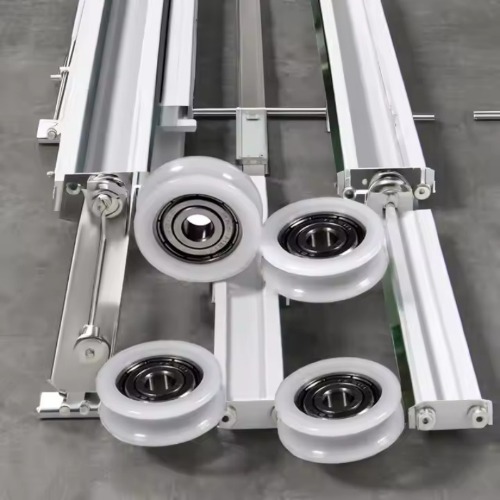
Bearing Types
Choose between ball bearings and plain bearings: Decide based on load, speed, accuracy, and cost requirements.
Ball bearings: For high speeds, medium to high loads, applications that require high efficiency and long life. They offer lower friction and higher accuracy.
Plain bearings: For low speeds, medium to low loads, cost-sensitive, or in harsh environments with dust, shock, etc., where higher friction and shorter life are acceptable. Some self-lubricating plastics are inherently plain bearings.
Plastic Bearing Pulley Maintenance and Care
Plastic bearing pulleys play an important role in modern equipment. With their lightness, low noise and corrosion resistance, they are widely used in industrial automation equipment, household appliances, door and window systems, fitness equipment, etc. However, in order to extend their service life and maintain their operating performance, daily maintenance and care cannot be ignored.
Why should plastic pulleys be maintained?
Although plastic pulleys themselves are not easy to rust and have a simple structure, they may still reduce performance or even cause failures after long-term operation due to dust accumulation, lubrication failure, wear or environmental influences. Timely maintenance can effectively:
Reduce wear rate
Reduce jamming and noise
Prevent bearing damage or pulley derailment
Extend the service life of the whole equipment
Maintenance points table for plastic bearing pulleys
| Maintenance items | Specific approach | Recommended frequency | Precautions |
| Clean surface dust | Use a dry cloth or compressed air to clean the dust and impurities on the pulley surface. | Weekly or by intensity of use | Avoid using corrosive cleaning agents |
| Lubricate bearings | Use the appropriate grease or oil according to the bearing type | Every 1-3 months | Closed bearings do not require lubrication; open bearings require regular relubrication |
| Check for wear | Check whether the wheel body is deformed or cracked, and whether the bearing is shaking or loose. | Monthly or regular inspection | If eccentric operation occurs, the pulley should be replaced immediately |
| Fastening parts inspection | Check whether the pulley and shaft are loose, and whether the screws and buckles are tight. | Quarterly or seasonal inspection | Prevent the pulley from falling off due to vibration |
| Prevent chemical corrosion | Avoid contact with strong acids, strong alkalis, solvents and other chemicals that are corrosive to plastics. | Long-term protection | Anti-corrosion coating or chemical resistant pulleys available |
| Anti-ultraviolet aging | When used outdoors, a sunshade should be installed or materials with UV stabilizers should be selected | One-time treatment before installation | UV rays can cause plastics to become brittle and crack |
| Temperature monitoring | Ensure that the pulley working environment temperature is within the allowable range of the material (e.g. -20°C~80°C) | Real-time monitoring or regular inspection | Heat-resistant pulleys should be used in high or low temperature environments |
Common maintenance misunderstandings
Ignoring lubrication: Although it is made of plastic, metal bearings may still be used inside, which require regular lubrication.
Excessive cleaning: Frequent use of chemical cleaning agents can easily damage the pulley surface or bearing seals.
Disease-involved operation: The pulley continues to be used even if it has slight shaking or abnormal noise, which may cause the bearing to get stuck or the equipment to be damaged.
Ignoring environmental factors: If it is exposed to high temperature, high humidity or dusty environment for a long time, a more frequent maintenance plan needs to be formulated.
Tips for extending the life of the pulley
Use closed dustproof bearings to reduce the ingress of impurities
Choose glass fiber reinforced plastics to improve wear resistance and strength
Avoid overload or impact loads
Replace aging pulleys regularly to reduce the risk of overall failure
Although plastic bearing pulleys are "low maintenance" components, they are not "maintenance-free". Regular inspection, cleaning, lubrication and environmental management can not only extend the life of the pulley itself, but also significantly improve the operating efficiency and safety of the entire system. For high-frequency operation or critical equipment, it is recommended to establish a special maintenance cycle and keep records.
Advantages of Metal Pulleys over Plastics
Strength: Metals (such as steel and aluminum) generally have much higher tensile strength, compressive strength and hardness than plastics, can withstand greater loads and impacts, and are not easily deformed.
Heat resistance: Metals can withstand higher operating temperatures without losing their mechanical properties or creeping or melting. This makes metal pulleys an irreplaceable choice in high-temperature environments.
Load Capacity: Due to their higher strength, metal pulleys are able to handle greater loads and forces, making them suitable for heavy industrial machinery and high-intensity transmissions.
Wear Resistance: Although some engineering plastics have good wear resistance, harder metals generally provide better long-term wear resistance in extremely high-pressure or high-abrasive environments.
Dimensional Stability: Metals generally have a lower coefficient of thermal expansion than plastics and are less likely to deform due to moisture absorption, which can maintain better dimensional stability in environments with large temperature and humidity changes.
When to Choose Plastic vs. Metal
Choose Plastic Pulleys:
Applications with light to medium loads.
Systems with strict weight requirements.
Where quiet operation or vibration reduction is required.
Where exposure to moisture, corrosive environments or certain chemicals is required.
Applications that are cost-sensitive and mass-produced.
Where non-conductive or self-lubricating properties are required.
Choose Metal Pulleys:
Applications with heavy loads or where high tension is required.
Operation in high-temperature environments.
Where extreme strength and stiffness are required.
Precision drives with extremely high demands on dimensional accuracy and stability.
Equipment operating under extreme wear conditions.
The final selection should be based on a comprehensive assessment of the application environment, load, speed, temperature, expected life and cost.
Future Trends in Plastic Bearing Pulleys
The field of plastic bearing pulleys is constantly evolving to meet the growing needs of various industries. Future trends will focus on materials, designs and application expansion.
Material Advances
New plastics, better performance: Research and development of more advanced engineering plastics is an important direction for the future.
Higher performance composites: Compound plastics with carbon fiber, glass fiber, ceramic particles or other nanomaterials to further improve their strength, stiffness, wear resistance, high temperature resistance and thermal conductivity, making them comparable to some metals while maintaining the lightweight and corrosion resistance advantages of plastics.
Enhanced self-lubricating properties: Develop polymer alloys with better self-lubricating properties or plastics containing solid lubricants (such as PTFE, graphite, molybdenum disulfide) to extend maintenance-free life and reduce friction coefficients.
Wider temperature range: Develop new plastics that can maintain stable performance in extremely high or low temperature environments to broaden their application range.
Bio-based and recyclable materials: With the improvement of environmental awareness, more bio-based, biodegradable or easily recyclable plastic materials will be used in pulley manufacturing in the future to reduce the environmental footprint.
Design innovation
Improved pulley design for better performance: Design optimization will improve the efficiency and function of plastic pulleys.
Lightweight and structural optimization: Using advanced topology optimization and finite element analysis techniques, pulley structures that are lighter and more efficient while maintaining strength can be designed to reduce material consumption.
Integrated functions: Integrate pulleys with other components (such as sensors, encoders, or connectors) into a single injection molded part to simplify assembly, reduce costs, and improve the level of system intelligence.
Quiet design: Further optimize noise reduction performance through material selection and structural design to meet application scenarios with higher requirements for quiet operation.
Modularity and standardization: Develop a more modular and standardized series of plastic pulleys, making it easier for customers to select and assemble, reducing customization costs.
Application growth
Emerging industries adopt plastic pulleys: The application of plastic pulleys will continue to expand to more emerging and high-tech fields.
Robotics and automation: With the popularization of industrial robots and automation equipment, the demand for lightweight, precision, and low-noise components will drive the widespread use of plastic pulleys in these fields.
Electric vehicles (EVs): In electric vehicles, the demand for lightweighting to increase driving range will prompt more plastic parts to replace metal, including pulleys in auxiliary systems.
Renewable Energy: The demand for weather-resistant, maintenance-free components in renewable energy equipment such as wind power generation and solar tracking systems will drive the application of plastic pulleys.
Medical and Pharmaceutical: Stringent requirements for cleanliness, corrosion resistance and lightweight will make plastic pulleys play a more important role in medical equipment, laboratory automation and pharmaceutical machinery.
Logistics and Warehousing Automation: With the development of e-commerce and smart warehousing, the demand for efficient and low-maintenance pulleys in automated sorting and conveying systems will continue to grow.
Conclusion
Plastic bearing pulleys have evolved from niche products to indispensable components in modern machinery and equipment. They have shown advantages over traditional metal pulleys in many applications due to their unique lightweight, corrosion resistance, significant noise reduction, cost-effectiveness and the self-lubricating properties of certain materials.
From busy industrial conveyor belts to precision 3D printers, from fitness equipment to harsh marine environments, the application range of plastic shaft wheels is expanding. Selecting the right plastic pulley requires a comprehensive consideration of key factors such as load capacity, environmental conditions, speed requirements, size and bearing type. Through proper cleaning, lubrication and regular inspection, their service life and performance can be maximized.
Looking to the future, with the continuous advancement of material science and innovation in design concepts, plastic bearing pulleys will become more powerful, efficient and intelligent, and play a core role in more emerging industries. They will continue to be a key force in promoting lighter, quieter, more durable and more sustainable solutions in all walks of life.






 English
English  Español
Español  日本語
日本語 